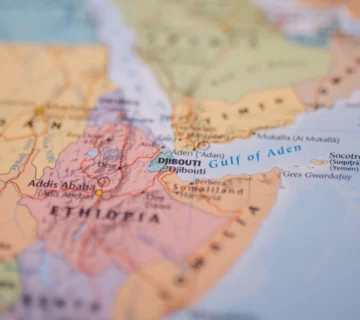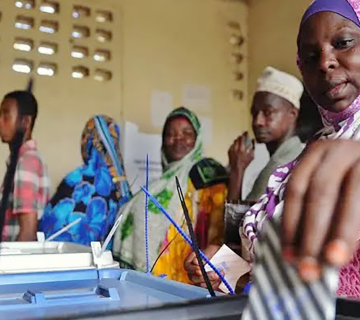The recent diplomatic row pitting Kenya against Somalia arising from a protracted maritime territorial dispute should not escalate. According to International Court of Justice (ICJ) (Press Release No. 2014/27 28 August 2014), the center of the dispute is 62,000 square miles of the Indian Ocean, alleged to be rich in hydrocarbons, for which Somalia took Kenya to the ICJ in 2014. But before the ICJ could arbitrate the matter, Somalia reportedly put up for auction some blocks in the disputed territory.
Kenya sent the Somalia ambassador back home, while summoning its own envoy from Mogadishu for further consultations. It is reassuring that Mogadishu moved expeditiously to dispute the reports that it had auctioned the blocks as it helped ease tensions between the two countries. The significant dispute is over whether the maritime border demarcation between Kenya and Somalia is eastward along the line of latitude (as Kenya claims) or continues along the same trajectory as the land border, the equidistant line (as Somalia claims).
The Genesis of the Conflict
The dispute between Kenya and Somalia can also be traced to the early 2000s, following Kenya’s granting of exploration concessions to companies. Somalia argued that its national laws were very clear in delimiting its maritime boundary, which included the contested maritime area (See Case concerning Maritime Delimitation in the Indian Ocean, ICJ, Somalia’s Memorial, July 2014, vol. I). Somalia also noted that Kenya had acknowledged the boundary. Somalia further asserted that Kenya had never granted oil exploration concessions in the contested area until the early 2000s. Kenya argued that it had exercised effective control of the area for many years and had also legally proclaimed since 1979 that its maritime boundary with Somalia followed a parallel line. Kenya added that it had reiterated this claim again in a 2005 Presidential Decree. It argues that in both instances Somalia did not object.
War on Al Shabab
A number of critical inferences can be made from this recent development. The dispute threatens to dent relations between the two neighbors that have fashioned an alliance in recent years to fight al Shabab militants who have waged an insurgency in Somalia since 2006. An escalation of the maritime row would negatively affect the war on terrorism.
According to The Dadaab Dilemma: A Study on Livelihood Activities and Opportunities for Dadaab Refugees report, 99 per cent of refugees in Dadaab are of Somali origin. In retrospect, as Kenya hosts the thousands of Somali nationals in the refugee camp, the row puts their safety on the line. The security sphere bounding both countries is very critical to have the countries relationship deteriorating.
Withdrawal of Kenyan Troops?
On whether the boundary spat could mean withdrawal of Kenyan troops from Somalia – it is highly unlikely. President Uhuru Kenyatta is on record calling for deployment of more troops in Somalia to wipe out the militants who have time and again, carried out attacks in Kenya. And in a recent media interview with BBC, Deputy President William Ruto reiterated Kenya’s commitment to the cause in Somalia. He said it would be reckless for Kenya to walk away from a threat that stalls her territory.
According to media reports, al Shabab forces took control of a town in Gedo on March 2, 2019 following the withdrawal of Kenya Defence Forces (KDF) soldiers serving under the African Union Mission to Somalia (AMISOM). KDF troops are reported to have moved out of the town of Fahfahdhun, retreating to Giriley near the Somalia-Kenya border. This is believed to have allowed al Shabab militants to recapture the town.
Notwithstanding fears that following the recent row, Kenyan troops in Somalia may face some sort of “rejection”, withdrawal could dent the gains made over the years. Such a move could also only make it more difficult to secure and stabilize the nation, and risk it falling back to al Shabab control.
AMISOM
The African Union Mission in Somalia was initially meant to deploy 8,000 troops for just six months in 2007 (see AMISOM Resolution 1744 (2007) Adopted by the Security Council at its 5633rd meeting, on 20 February 2007). However, its mandate consistently renewed and expanded. Kenya, Ethiopia, Uganda, Djibouti, and Burundi have since jointly contributed 22,000 troops as dynamics of the terrorism threat keep changing.
AMISOM restored peace and security, repulsing al Shabab from their strongholds. This pacification allowed Somali leaders to engage different stakeholders over the conflict. The forces sustained a military presence and undertook counter-radicalization programs (AU, 2014). These achievements are slowly restoring Somalia’s state sovereignty (Fisher, 2013). Previous interventions registered minimal successes, a reason why radical groups like al Shabab became strong.
According to AMISOM, Concept of Operations (CONOPs) 2018–2021 unless the schedule is revised, combat troops are scheduled to withdraw from all of Somalia’s cities, towns and villages that they’ve liberated from al Shabab terrorist organization and Somali security institutions taking the lead by December 2021. In such eventuality the al Shabab militants will likely rebuild their capacities and intensify attacks which will be detrimental to both Kenya and Somalia. Simply put, a pull-out would compound the problem.
There is no doubt that this dispute has strained the relationship between Kenya and Somalia – two countries that have a lot at stake. Accordingly, it is mutually beneficial for two to solve their grievances diplomatically. Severed ties would give the Islamists a leeway to flex muscles and further cause havoc in the Horn of Africa.
Hassan Mutubwa is a Countering Violent Extremism (CVE) Specialist.
This article was originally published on Mediamax on March 1, 2019.



